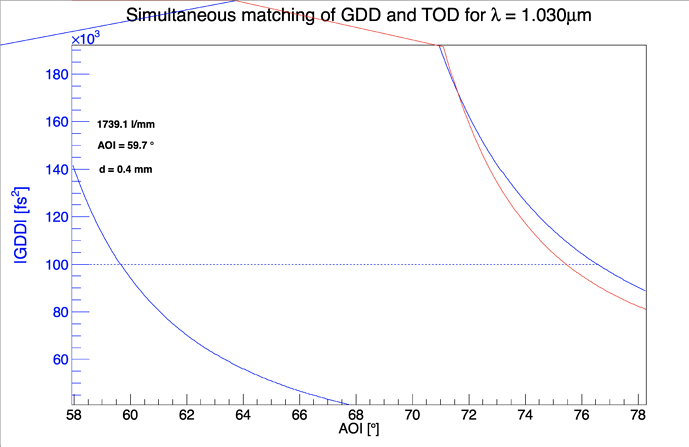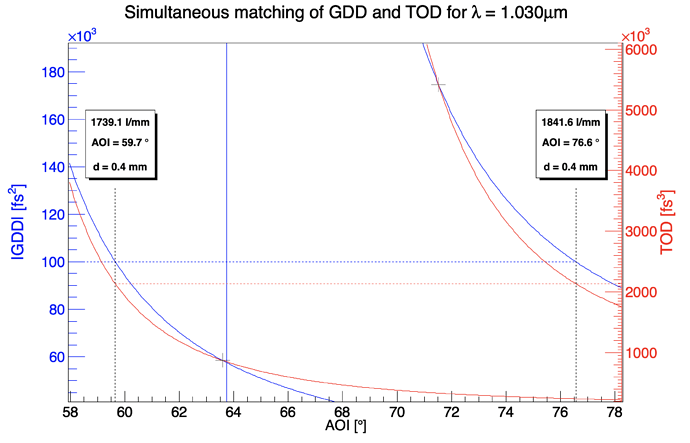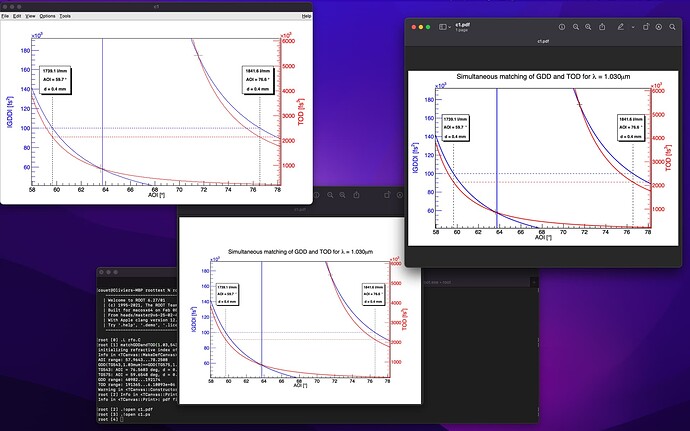Ok, I significantly shortened my macro and included some library functions, for me it works standalone now:
const double AOI_MIN = 5.0; // initialize minimum AOI to 5° for graph
const double AOI_MAX = 85.0; // initialize maximum AOI to 85° for graph and for calculation
const int LIGHTSPEED = 299792458; // c in vacuum in m/s
const int NUM_X1 = 500; // number of sampling points for graphs (first independent variable)
const int NUM_X2 = 100; // number of sampling points for graphs (second independent variable)
const double DUMMY_LAMBDA_MIN = -1;
const double DUMMY_LAMBDA_MAX = 123456789;
const double PRECISION = 0.00001; // 0.01 nm precision required for iterative calculation of lambda
const double LITTROW_MAX = 75.0; // set maximum Littrow to 75° for plotting (to avoid divergence)
const int DO_MAX = 10; // maximum diffraction order
enum MEDIUM{AIR,SUBSTRATE};
int canvas_counter = 1;
enum DISPERSION_ORDER{GDD,TOD,TODoverGDD};
const double approx_refractive_index = 1.45; // n = 1.45 for Suprasil 3002 between 752.5nm...1400nm
TGraph *Suprasil3002; // refractive index for Suprasil 3002
void initializeSuprasil3002()
{
// data from Heraeus datasheet
cout << "initializing refractive index of Suprasil 3002 ..." << endl;
double x[] = {0.36548,0.380,0.400,0.40465,0.43583,0.4416,0.4471,0.48613,0.488,0.5145,0.532,0.54607,0.58756,0.6328,0.65627,0.6943,0.7525,0.800,0.850,0.900,0.905,1.000,1.064,1.153,1.200,1.319,1.400,1.600};
double y[] = {1.4748,1.4728,1.4704,1.4699,1.4670,1.4665,1.4661,1.4634,1.4633,1.4619,1.4610,1.4604,1.4588,1.4573,1.4567,1.4557,1.4545,1.4536,1.4528,1.4520,1.4520,1.4507,1.4499,1.4489,1.4483,1.4470,1.4461,1.4437};
Suprasil3002 = new TGraph(28,x,y);
Suprasil3002->Draw();
}
TCanvas* getCanvas()
{
string canvasName = "c";
canvasName += to_string(canvas_counter);
//TCanvas *canvas = (TCanvas*)gROOT->GetListOfCanvases()->FindObject(canvasName);
//TCanvas *canvas = new TCanvas(canvasName.c_str(),canvasName.c_str(),600,400);
TCanvas *canvas = new TCanvas(canvasName.c_str(),canvasName.c_str(),1200,800);
canvas_counter++;
return canvas;
}
double getRefractiveIndex(double lambda)
{
// lambda in mum
if (Suprasil3002 == NULL) {
initializeSuprasil3002();
}
//if ((lambda<0.365) || (lambda>1.6))
//cout << "Achtung: value of refractive index of Suprasil 3002 at lambda = " << roundToNDigits(lambda,3) << " mum is not reliable!" << endl;
//cout << Suprasil3002->Eval(lambda) << endl;
//return 1.45;
return Suprasil3002->Eval(lambda);
}
string roundToNDigits(double x, int n, bool include_sign)
{
double rounded = floor(x*TMath::Power(10,n)+0.5)/TMath::Power(10,n);
string longString = to_string(rounded);
string shortString = longString.substr(0,longString.find(".")+n+1);
if (include_sign && (x>=0.0))
shortString.insert(0,"+");
return shortString;
}
string roundToNDigits(double x, int n)
{
return roundToNDigits(x,n,false);
}
string roundToNSignedDigits(double x, int n)
{
return roundToNDigits(x,n,true);
}
string getLineDensity(int period)
{
// period in nm
int num_digits = 1;
double line_density = (double)TMath::Power(10,6)/period; // line density in 1/mm
string text = roundToNDigits(line_density,num_digits) + " l/mm";
return text;
}
double getLambdaMinWithoutHigherOrderDiffraction(int period)
{
// minimum lambda before onset of higher order diffraction
// lambda_min in mum, period in nm
double DO_minusTwo_in_air = 2*(double)period/1000/3; // onset of diffraction order m = -2 (or +1) in air
double initial_index = approx_refractive_index;
double lambda = initial_index*DO_minusTwo_in_air;
while (TMath::Abs(getRefractiveIndex(lambda)*DO_minusTwo_in_air - lambda) > PRECISION) {
lambda = getRefractiveIndex(lambda)*DO_minusTwo_in_air;
//cout << lambda << endl;
}
return lambda;
}
double getLambdaMaxAtLittrowMax(int period)
{
// lambda_max in mum, period in nm
double littrow_max = LITTROW_MAX/180.0*TMath::Pi();
double max = 2*(double)period/1000*sin(littrow_max);
return max;
}
double getLittrowAngle(int period, double lambda)
{
// period in nm, lambda in mum
const int m = -1; // diffraction order -1
double lambda_nm = lambda*1000;
double littrow = TMath::ASin(-m*lambda_nm/2/period);
return littrow/TMath::Pi()*180.0; // littrow angle in degrees
}
double aod_vs_aoi(double *var, double *par)
{
// var[0] = external angle of incidence in degrees
// par[0] = lambda in mum
// par[1] = period in mum
// par[2] = transmission order
// par[3] = MEDIUM (AIR or SUBSTRATE)
double input_angle = var[0]*TMath::Pi()/180.0; // convert angle from degrees to radians
double lambda = par[0];
int m = (int)par[2];
MEDIUM medium = (MEDIUM)par[3];
double index = (medium==SUBSTRATE) ? getRefractiveIndex(lambda) : 1;
double output_angle = TMath::ASin((TMath::Sin(input_angle)+m*lambda/par[1])/index);
return output_angle/TMath::Pi()*180.0; // aod in degress
}
double getDiffractionAngle(double aoi, double lambda, int period, int order = -1, MEDIUM medium = AIR)
{
// aoi in degrees, lambda in mum, period in nm
TF1 *f1 = new TF1("f_aod_vs_aoi",aod_vs_aoi,0,90,4);
f1->SetParameter(0,lambda);
f1->SetParameter(1,(double)period/1000);
f1->SetParameter(2,(double)order);
f1->SetParameter(3,(double)medium);
return f1->Eval(aoi);
}
double getIncidentAngle(double aod, double lambda, int period)
{
// aod in degrees, lambda in mum, period in nm, diffraction order set to -1
const int m = (aod<=0.0) ? -1 : 1; // sign convention for transission order
return getDiffractionAngle(aod,lambda,period,-m,AIR); // AOI(AOD) = AOD(AOI) with m replaced by -m
}
double gdd_littrow(double *var, double *par)
{
// var[0] = distance d in mm
// var[1] = lambda in micrometer
// par[0] = period in mum
// Littrow cinfiguration
const int m = -1; // transmission order
const int passes = 2;
double d = var[0]*1000; // convert d from mm to mum
double lambda = var[1];
const double v_c = LIGHTSPEED*TMath::Power(10,-9); // c in micrometer/femtosecond
double f = -passes*2*d*lambda/TMath::Pi()/v_c/v_c*m*m*lambda*lambda/4/par[0]/par[0]*TMath::Power(1-m*m*lambda*lambda/4/par[0]/par[0],-1.5);
return f;
}
double gdd(double *var, double *par)
{
// var[0] = lambda in micrometer
// var[1] = aoi in degrees
// par[0] = period in mum
// par[1] = distance d in mm
const int m = -1; // transmission order
const int passes = 2;
double d = par[1]*1000; // convert d from mm to mum
double lambda = var[0];
double sin_aoi = TMath::Sin(var[1]*TMath::Pi()/180); // sin(aoi)
const double v_c = LIGHTSPEED*TMath::Power(10,-9); // c in micrometer/femtosecond
double f = -passes*d*lambda*lambda*lambda*m*m/2/TMath::Pi()/v_c/v_c/par[0]/par[0]*TMath::Power(1-(sin_aoi+m*lambda/par[0])*(sin_aoi+m*lambda/par[0]),-1.5);
return f;
}
double tod_over_gdd_littrow(double *var, double *par)
{
// var[0] = lambda in micrometer
// par[0] = period in mum
// Littrow cinfiguration
const int m = -1; // transmission order
double lambda = var[0];
const double v_c = LIGHTSPEED*TMath::Power(10,-9); // c in micrometer/femtosecond
double f = -3*lambda/2/TMath::Pi()/v_c*(1+m*m*lambda*lambda/4/par[0]/par[0])/(1-m*m*lambda*lambda/4/par[0]/par[0]);
return f;
}
double tod_over_gdd(double *var, double *par)
{
// var[0] = lambda in micrometer
// var[1] = aoi in degrees
// par[0] = period in mum
const int m = -1; // transmission order
double lambda = var[0];
double sin_aoi = TMath::Sin(var[1]*TMath::Pi()/180); // sin(aoi)
const double v_c = LIGHTSPEED*TMath::Power(10,-9); // c in micrometer/femtosecond
double f = -3*lambda/2/TMath::Pi()/v_c*(1+m*lambda/par[0]*(sin_aoi+m*lambda/par[0])/(1-(sin_aoi+m*lambda/par[0])*(sin_aoi+m*lambda/par[0])));
return f;
}
double calculateAOIforTODoverGDDmatching(double lambda, int period1, int period2, double aoi1)
{
const int m = -1; // diffraction order = -1
double p1 = (double)period1/1000; // period_1 in mum
double p2 = (double)period2/1000; // period_2 in mum
double sin_aoi1 = TMath::Sin(aoi1*TMath::Pi()/180); // sin(aoi_1)
double sin_aod1 = sin_aoi1 + m*lambda/p1; // sin(aod_1)
double b = 1-sin_aod1*sin_aod1; // expression in brackets
double sin_aod2 = (TMath::Sqrt(p1*p1*b*b + 4*p2*p2*sin_aod1*sin_aod1) - p1*b)/2/p2/sin_aod1; // sin(aod_2) for negative aod
double sin_aoi2 = sin_aod2 - m*lambda/p2; // sin(aoi_2)
double aoi2 = TMath::ASin(sin_aoi2)*180/TMath::Pi(); // aoi_2 in degrees
return aoi2;
}
double calculateAOIforGivenTODoverGDD(int period, double lambda, double gdd, double tod)
{
const int m = -1; // diffraction order = -1
double p = (double)period/1000; // period in mum
const double v_c = LIGHTSPEED*TMath::Power(10,-9); // c in micrometer/femtosecond
double a = -p/m/lambda*(1 + 2*TMath::Pi()*v_c/3/lambda*tod/gdd);
double sin_aod = (TMath::Sqrt(1+4*a*a)-1)/2/a;
double sin_aoi = sin_aod - m*lambda/p;
double aoi = TMath::ASin(sin_aoi)*180/TMath::Pi();
return aoi;
}
double calculateDistanceForGivenAOIandGDD(int period, double lambda, double gdd, double aoi_deg)
{
const int m = -1; // diffraction order = -1
double p = (double)period/1000; // period in mum
const double v_c = LIGHTSPEED*TMath::Power(10,-9); // c in micrometer/femtosecond
const int passes = 2;
double aoi = aoi_deg/180*TMath::Pi();
double sin_aod = TMath::Sin(aoi) + m*lambda/p;
double d = -gdd*2*TMath::Pi()*v_c*v_c*p*p/passes/m/m/lambda/lambda/lambda*TMath::Power(1-sin_aod*sin_aod,1.5);
return d/1000; // convert to mm
}
///////////////////////////////////// plot macros /////////////////////////////////////
void matchGDDandTOD(double lambda, int period1, int period2, double targetGDD, double targetTOD = DUMMY_LAMBDA_MIN)
{
double lambda_min = getLambdaMinWithoutHigherOrderDiffraction(period1);
double lambda_max = getLambdaMaxAtLittrowMax(period1);
double littrow1 = getLittrowAngle(period1, lambda);
double littrow2 = getLittrowAngle(period2, lambda);
// find x-axis range:
double x_margin = 0.1;
// if targetTOD is not specified, match AODs (use arithmetic average as AOD for period1):
double aoi_match1 = (targetTOD==DUMMY_LAMBDA_MIN) ? getIncidentAngle(-(littrow1+littrow2)/2,lambda,period1) : calculateAOIforGivenTODoverGDD(period1,lambda,targetGDD,targetTOD);
double aoi_match2 = calculateAOIforTODoverGDDmatching(lambda,period1,period2,aoi_match1);
double delta_aoi = TMath::Abs(aoi_match2-aoi_match1);
double aoi1 = min(aoi_match1,aoi_match2) - x_margin*delta_aoi;
double aoi2 = max(aoi_match1,aoi_match2) + x_margin*delta_aoi;
cout << "AOI range: " << aoi1 << "..." << aoi2 << endl;
double d1 = calculateDistanceForGivenAOIandGDD(period1,lambda,targetGDD,aoi_match1);
double d2 = calculateDistanceForGivenAOIandGDD(period2,lambda,targetGDD,aoi_match2);
cout << "GDD(TG" << period1 << "," << lambda << "mum)==GDD(TG" << period2 << "," << lambda << "mum) AND TOD(TG" << period1 << "," << lambda << "mum)==TOD(TG" << period2 << "," << lambda << "mum) for:" << endl;
cout << "TG" << period1 << ": AOI = " << aoi_match1 << " deg, d = " << d1 << " mm" << endl;
cout << "TG" << period2 << ": AOI = " << aoi_match2 << " deg, d = " << d2 << " mm" << endl;
// find y-axes range:
double y_margin = 0.15;
TF2 *f2_gdd = new TF2("f_gdd",gdd,lambda_min,lambda_max,aoi1,aoi2,2);
TF2 *f2_tog = new TF2("f_todovergdd",tod_over_gdd,lambda_min,lambda_max,aoi1,aoi2,1);
f2_gdd->SetParameter(0,(double)period1/1000);
f2_gdd->SetParameter(1,d1);
f2_tog->SetParameter(0,(double)period1/1000);
double gdd1_littrow = TMath::Abs(f2_gdd->Eval(lambda,littrow1));
double tod1_littrow = f2_gdd->Eval(lambda,littrow1)*f2_tog->Eval(lambda,littrow1);
f2_gdd->SetParameter(0,(double)period2/1000);
f2_gdd->SetParameter(1,d2);
f2_tog->SetParameter(0,(double)period2/1000);
double gdd2_littrow = TMath::Abs(f2_gdd->Eval(lambda,littrow2));
double tod2_littrow = f2_gdd->Eval(lambda,littrow2)*f2_tog->Eval(lambda,littrow2);
double delta_gdd = TMath::Abs(gdd2_littrow-gdd1_littrow);
double gdd_min = min(gdd1_littrow,gdd2_littrow) - y_margin*delta_gdd;
double gdd_max = max(gdd1_littrow,gdd2_littrow) + y_margin*delta_gdd;
cout << "GDD range: " << gdd_min << "..." << gdd_max << endl;
double delta_tod = TMath::Abs(tod2_littrow-tod1_littrow);
double tod_min = min(tod1_littrow,tod2_littrow) - y_margin*delta_tod;
double tod_max = max(tod1_littrow,tod2_littrow) + y_margin*delta_tod;
cout << "TOD range: " << tod_min << "..." << tod_max << endl;
// make graphs:
vector<double> x, x_tod1, x_tod2, y_gdd1, y_gdd2, y_tod1, y_tod2;
for (int j=0; j<NUM_X1; j++) {
double aoi = aoi1 + (aoi2-aoi1)/(NUM_X1-1)*j;
f2_gdd->SetParameter(0,(double)period1/1000);
f2_gdd->SetParameter(1,d1);
double gdd1 = TMath::Abs(f2_gdd->Eval(lambda,aoi));
f2_gdd->SetParameter(0,(double)period2/1000);
f2_gdd->SetParameter(1,d2);
double gdd2 = TMath::Abs(f2_gdd->Eval(lambda,aoi));
x.push_back(aoi);
y_gdd1.push_back(gdd1);
y_gdd2.push_back(gdd2);
}
for (int j=0; j<NUM_X1; j++) {
double aoi = aoi1 + (aoi2-aoi1)/(NUM_X1-1)*j;
f2_gdd->SetParameter(0,(double)period1/1000);
f2_gdd->SetParameter(1,d1);
f2_tog->SetParameter(0,(double)period1/1000);
double tod = f2_gdd->Eval(lambda,aoi)*f2_tog->Eval(lambda,aoi);
if ((tod<tod_min) || (tod>tod_max))
continue;
x_tod1.push_back(aoi);
y_tod1.push_back(tod);
}
for (int j=0; j<NUM_X1; j++) {
double aoi = aoi1 + (aoi2-aoi1)/(NUM_X1-1)*j;
f2_gdd->SetParameter(0,(double)period2/1000);
f2_gdd->SetParameter(1,d2);
f2_tog->SetParameter(0,(double)period2/1000);
double tod = f2_gdd->Eval(lambda,aoi)*f2_tog->Eval(lambda,aoi);
if ((tod<tod_min) || (tod>tod_max))
continue;
x_tod2.push_back(aoi);
y_tod2.push_back(tod);
}
TGraph *g_gdd1 = new TGraph(x.size(),&(x[0]),&(y_gdd1[0]));
TGraph *g_tod1 = new TGraph(x_tod1.size(),&(x_tod1[0]),&(y_tod1[0]));
TGraph *g_gdd2 = new TGraph(x.size(),&(x[0]),&(y_gdd2[0]));
TGraph *g_tod2 = new TGraph(x_tod2.size(),&(x_tod2[0]),&(y_tod2[0]));
// plot:
TCanvas *canvas = getCanvas();
int gdd_color = kBlue;
int tod_color = kRed;
double dx = (aoi2-aoi1)/0.8; // 10 per cent margins left and right
double dy_gdd = (gdd_max-gdd_min)/0.8; // 10 per cent margins left and right
double dy_tod = (tod_max-tod_min)/0.8; // 10 per cent margins left and right
TPad *pad1 = new TPad("pad1","",0,0,1,1);
pad1->Range(aoi1,gdd_min-0.1*dy_gdd,aoi2,gdd_max+0.1*dy_gdd);
TPad *pad2 = new TPad("pad2","",0,0,1,1);
pad2->Range(aoi1-0.1*dx,tod_min-0.1*dy_tod,aoi2+0.1*dx,tod_max+0.1*dy_tod);
pad2->SetFillStyle(4000); //will be transparent
pad1->Draw();
pad1->cd();
g_gdd1->Draw();
g_gdd1->SetLineColor(gdd_color);
g_gdd1->GetXaxis()->SetRangeUser(aoi1,aoi2);
g_gdd1->GetXaxis()->SetTitle("AOI [#circ]");
g_gdd1->GetXaxis()->CenterTitle();
g_gdd1->GetYaxis()->SetRangeUser(gdd_min,gdd_max);
g_gdd1->GetYaxis()->SetAxisColor(gdd_color);
g_gdd1->GetYaxis()->SetLabelColor(gdd_color);
g_gdd1->GetYaxis()->SetTitle("|GDD| [fs^{2}]");
g_gdd1->GetYaxis()->SetTitleSize(0.04);
g_gdd1->GetYaxis()->SetTitleColor(gdd_color);
g_gdd1->GetYaxis()->CenterTitle();
string title = "Simultaneous matching of GDD and TOD for #lambda = " + roundToNDigits(lambda,3) + "#mum";
g_gdd1->SetTitle(title.c_str());
g_gdd1->Draw();
canvas->Update();
g_gdd2->Draw("same");
g_gdd2->SetLineColor(gdd_color);
g_gdd1->SetLineWidth(2);
g_gdd2->SetLineWidth(2);
g_gdd2->Draw("same");
g_gdd1->Draw("same");
canvas->Update();
TLine *l_gdd = new TLine(aoi1,g_gdd2->Eval(aoi_match2),max(aoi_match1,aoi_match2),g_gdd1->Eval(aoi_match1));
l_gdd->SetLineStyle(2);
l_gdd->SetLineColor(gdd_color);
l_gdd->Draw();
pad1->Update();
pad2->Draw();
pad2->cd();
g_tod2->Draw("same");
g_tod1->Draw("same");
g_tod1->GetYaxis()->SetRangeUser(tod_min,tod_max);
g_tod2->GetYaxis()->SetRangeUser(tod_min,tod_max);
g_tod1->SetLineColor(tod_color);
g_tod2->SetLineColor(tod_color);
g_tod1->SetLineWidth(2);
g_tod2->SetLineWidth(2);
//g_tod1->Draw("same");
//g_tod2->Draw("same");
pad2->Update();
//double hack_factor = 1.00035;
//TGaxis *axis = new TGaxis(aoi2*hack_factor,tod_min,aoi2*hack_factor,tod_max,tod_min,tod_max,50510,"+L");
TGaxis *axis = new TGaxis(aoi2,tod_min,aoi2,tod_max,tod_min,tod_max,50510,"+L");
axis->SetLabelColor(tod_color);
axis->SetLabelSize(0.035);
axis->SetLabelFont(42);
axis->SetLineColor(tod_color);
axis->SetTitle("TOD [fs^{3}]");
axis->SetTitleSize(0.04);
axis->SetTitleFont(42);
axis->SetTitleColor(tod_color);
axis->CenterTitle();
axis->Draw();
//pad2->Update();
TLine *l_match1 = new TLine(aoi_match1,tod_min,aoi_match1,tod_min+0.6*(tod_max-tod_min));
l_match1->SetLineStyle(2);
l_match1->Draw();
TLine *l_match2 = new TLine(aoi_match2,tod_min,aoi_match2,tod_min+0.6*(tod_max-tod_min));
l_match2->SetLineStyle(2);
l_match2->Draw();
TLine *l_tod = new TLine(min(aoi_match1,aoi_match2),g_tod1->Eval(aoi_match1),aoi2,g_tod1->Eval(aoi_match1));
l_tod->SetLineStyle(2);
l_tod->SetLineColor(tod_color);
l_tod->Draw();
//pad2->Update();
TMarker *tm1 = new TMarker();
tm1->SetNDC(true);
tm1->SetMarkerStyle(2);
tm1->SetMarkerSize(3);
tm1->DrawMarker(littrow1,tod1_littrow);
TMarker *tm2 = new TMarker();
tm2->SetNDC(true);
tm2->SetMarkerStyle(2);
tm2->SetMarkerSize(3);
tm2->DrawMarker(littrow2,tod2_littrow);
bool p1Right = (period1<period2);
TPaveText *pt1 = new TPaveText((p1Right)?0.775:0.125,0.6,(p1Right)?0.875:0.225,0.75,"NDC");
pt1->SetFillColor(0);
pt1->SetFillStyle(4000);
pt1->SetTextSize(0.025);
pt1->AddText(getLineDensity(period1).c_str());
string aoi_match1_str = "AOI = " + roundToNDigits(aoi_match1,1) + " #circ";
pt1->AddText(aoi_match1_str.c_str());
string d1_str = "d = " + roundToNDigits(d1,1) + " mm";
pt1->AddText(d1_str.c_str());
pt1->Draw("same");
TPaveText *pt2 = new TPaveText((p1Right)?0.125:0.775,0.6,(p1Right)?0.225:0.875,0.75,"NDC");
pt2->SetFillColor(0);
pt2->SetFillStyle(4000);
pt2->SetTextSize(0.025);
pt2->AddText(getLineDensity(period2).c_str());
string aoi_match2_str = "AOI = " + roundToNDigits(aoi_match2,1) + " #circ";
pt2->AddText(aoi_match2_str.c_str());
string d2_str = "d = " + roundToNDigits(d2,1) + " mm";
pt2->AddText(d2_str.c_str());
pt2->Draw("same");
pad2->Update();
g_tod1->Draw("same");
pad2->Update();
}


